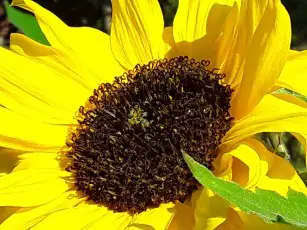When you see a sunflower, it’s natural to ask why are sunflowers yellow? In this article, I’ll be answering what makes sunflower petals yellow, and how we actually see their yellow-ness.
I’ll show you what yellow looks like to pollinators, like bees and butterflies, and how they don’t see yellow as we do, and why yellow is so important in nature.
First, here’s the quick answer, then we’ll dive into some details…
So, why are sunflowers yellow? Sunflowers are yellow because they extract carotenoids from the soil, which produces the color yellow. We see yellow because that light frequency does not get absorbed by their petals, so bounces yellow back into our eyes.
Pollinators see yellow differently and we’ll explore why shortly.
I’ve loved growing sunflowers since I was a child, with each one I’ve grown I’ve gloried at their bright yellow petals, and how they make me feel happy.
I’ve taken for granted that sunflowers are yellow, and never thought about why they’re yellow, but, I have been asked this question on more than one occasion.
so, having my curiosity fed I thought I’d dig a little deeper…’scuse the pun :)… and find out the reasons why sunflowers are yellow.
A sunflowers’ yellow petals play an important part in how it produces seeds. but first…
What is a Sunflower?
The common sunflower, Helianthus Annus is a tall plant with a single large flower. It has a dark and fuzzy center disc and is surrounded by lots of long, bright yellow petals.
Flowers are usually brightly colored so they can attract insects to get pollinated.
Pollination is the main goal of a flower’s lifecycle, this produces seeds to grow new plants and flowers.
Sunflowers are no different, they need to be pollinated too. And the reason why and how they are yellow is both amazing and fascinating. So let’s explore this further.
Why Sunflowers are yellow
As it grows, a sunflower will take in fluids and nutrients from the soil. Among these nutrients is a chemical known as a carotenoid.
Inside carotenoid is an organic pigment called carotene. When carotene is absorbed it gives part of a plant, like sunflower petals, their yellow color.
Carotene can be found in other yellow flowers too, like daffodils, as well as fruits and vegetables like corn, peppers, pineapples, and lemons.
How humans see yellow Sunflowers
Colorimetry is the name given to the science of seeing color.
We can only see three colors, red, green and blue. These three colors have a corresponding light frequency.
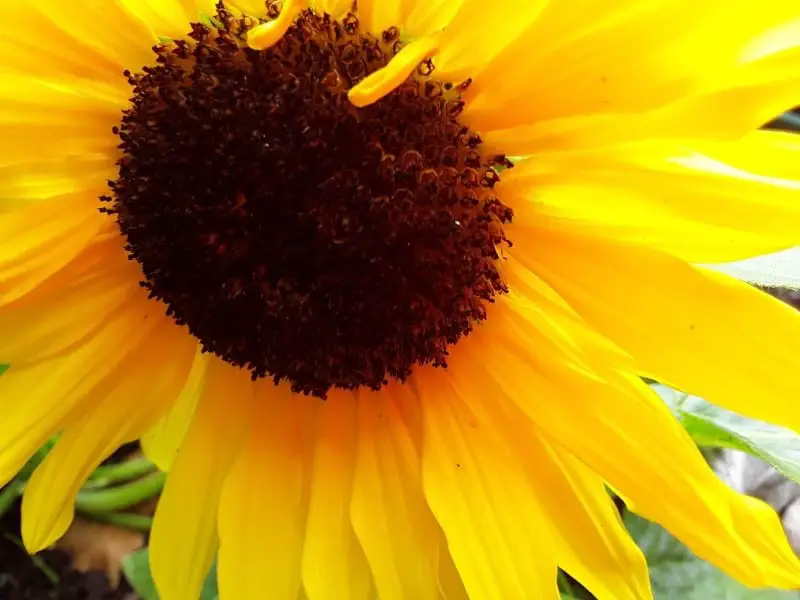
Humans are ‘trichromats’, tri, meaning three, and chroma, from the Greek word meaning color.
When the three colors we can see – red, green and blue are combined in our eyes, they produce all the other colors we see, including yellow.
Yellow is one of the brightest colors in nature, other than white. So, If we can only see three colors, and none of them are yellow then how can we see yellow?
Well, here’s the deal. We can’t actually see the color yellow, but when we see the colors green and red, the color yellow is a single light frequency halfway between these two colors.
The color yellow falls between green and red on the light frequency chart, and our brains have learned to register that yellow is not quite green or red so it must be yellow.
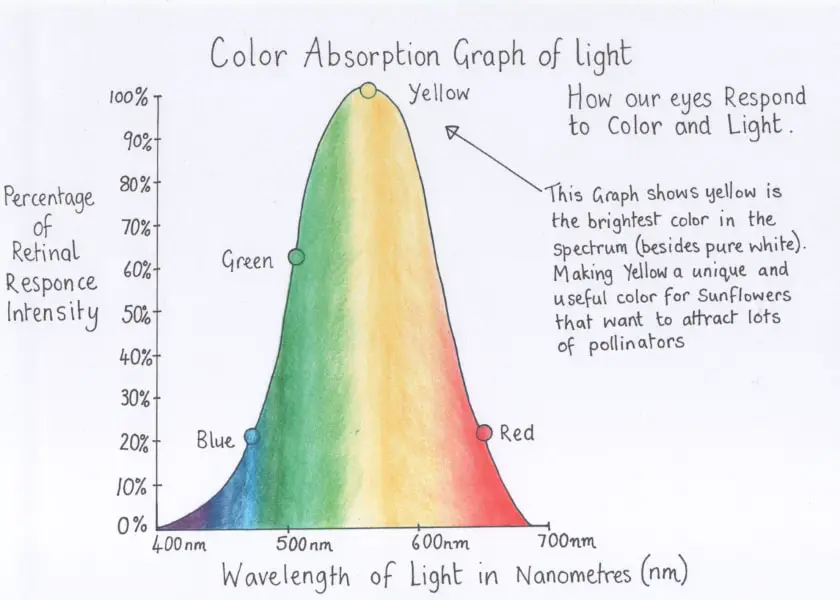
This is a light frequency chart showing yellow is situated between red and green.
Ok, so now we know carotene in the soil makes sunflowers petals yellow. And how we register yellow as the color in between green and red on the light spectrum…
What’s curious now is ‘why did nature make sunflowers yellow?’ And why is this the best color to attract butterflies and bees? And do these little beasties see yellow as we do? Let’s tackle that next…
How yellow Sunflowers attract pollinators
Insects are attracted to flowers by how they look and smell. so the answer is yes, yellow is one of the best colors to attract Pollinating bugs, and this is why…
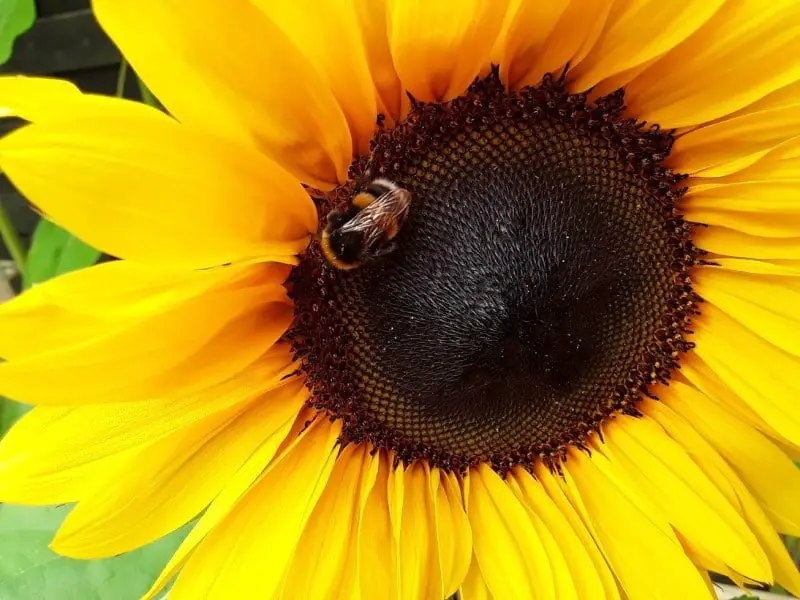
Flowers need to be pollinated so they can produce the next generation of seeds to be planted the following year. This is a flower’s main goal in life, to produce seeds.
The bigger and brighter a flower is, gets the best chance and success for being pollinated.
So a large blooming yellow sunflower, with lots of long brightly colored petals, wafting in the breeze, will attract the attention of many obliging bugs. But do insects see yellow as we do?
…a flower’s main goal in life is to produce seeds.
How bees, butterflies, and bugs see yellow Sunflowers?
No, they don’t. This surprised me too, so I needed to know why one of the brightest colors we can see, and be attracted to, wasn’t the same for the all important pollinators of our world.
Most Insects and bugs see colors in an ultraviolet light frequency, so a color we see will appear to be another color to them.
We see yellow sunflowers, but insects and bugs see a bright purple ultraviolet glowing flower that is so attractive, they can’t keep away from it.
And this is why our yellow helps insects see in a different light.
This is why most sunflowers are yellow. It’s the brightest color for an insect to be lured in and aid in the reproduction of seeds.
The large, long and bright yellow petals of a sunflower, and the dark fuzzy center is like a huge target that a pollinator can’t resist aiming for. And that’s just what the yellow sunflower wants.
And that’s why sunflowers are yellow.
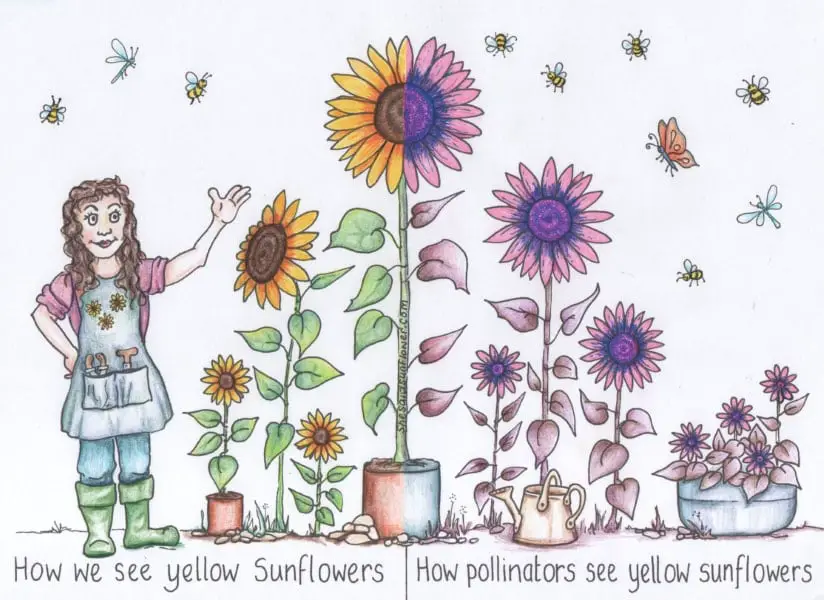
this is how we see the color yellow, and how pllinators see yellow

A gift to parents and educators
If you’d like to download this picture to color in, please feel free to do so. Just click this picture, right-click, and select save image as.
Blue and green aren’t the most attractive colors to bees and other small beasties.
These colors aren’t as vivid as yellow when they see them, especially when they are out to feed on nectar and pollen from flowers, so they don’t waste their crucial energy bumbling around trying to find a food source.
But, when they need shelter for their young, they will seek these colors out, as a safe place to lay their eggs, such as underneath green leaves.
Are all Sunflowers yellow?
They were all yellow, but No, they aren’t now. And this is why and how.
Over two thousand years ago, in South America, sunflowers were the main crop. They were tall and had big blooms that yielded a large number of seeds.
These seeds were used, amongst other things, for food, oil, medicines, and dyes.
Back then they all had yellow petals. Nature knew this was one of the most attractive colors for pollinators, as we have found out.
However, a few hundred years ago, sunflowers became very popular for the nobilities of the world, and then for us to grow in our gardens too.
I was amazed to find out that Kings, Queens, and Emperors of old loved sunflowers and then influenced the development of different colors and varieties of sunflowers.
How science and nature helped that happen
Genetic botanists started cross-breeding sunflowers as a challenge to create lots of different varieties and colors. And with more control in scientific development, we now have over 70 varieties of sunflowers.
The colors of these sunflowers range from golden yellows to oranges and reds, and even a variety of purple.
There are tall, giant headed sunflowers, multiheaded and dwarf sunflowers, and even pollen-less sunflowers for people with allergies, or for flower arranging. Sunflowers that will please everyone.

All these varieties, that I’ve had the pleasure of growing will attract pollinators too. And they look as fantastic in our gardens as the majestic and iconic yellow sunflower that has always put a smile on my face.
Here are more fascinating realted articles about sunflowers you may find interesting too.
31 Most Wonderful Sunflowers, With height Guide.
50 Amazing Facts about Sunflowers.
Why are Sunflowers Tall?
How do Sunflowers Pollinate?
Do Sunflowers Follow the Sun?
The Fear of Sunflowers
My Conclusion
So, there we have it. We may take yellow sunflowers for granted, but in actual fact its the evolution of nature helping sunflowers to get their job done.
By being the brightest yellow it can be, it will entice the most pollinators for the production of seeds. This is the sunflowers’ main goal in life.
And because of science, we have a greater understanding of why sunflowers are yellow, by the carotene pigment being drawn into the petals.
How yellow light waves are perceived by our eyes, and how insects see yellow in ultraviolet, which ultimately attracts them to their food source.
I hope this article has helped you with the hows and whys sunflowers are yellow. And how nature always seems to know best :).

